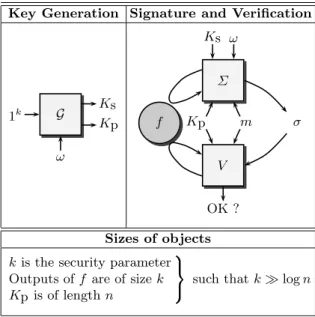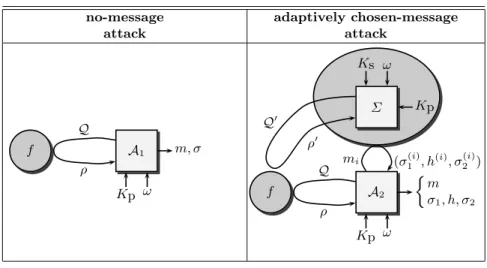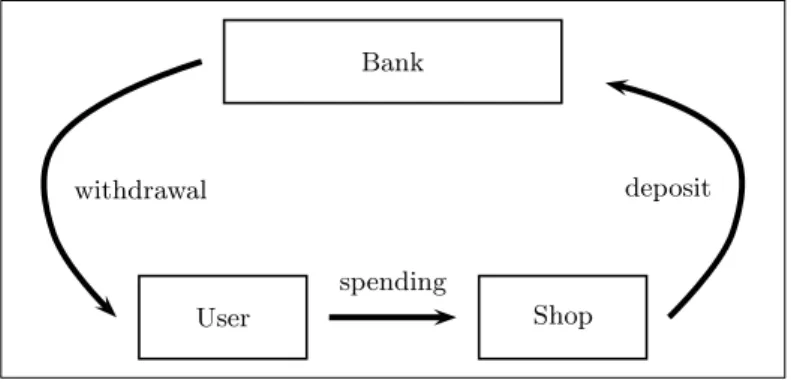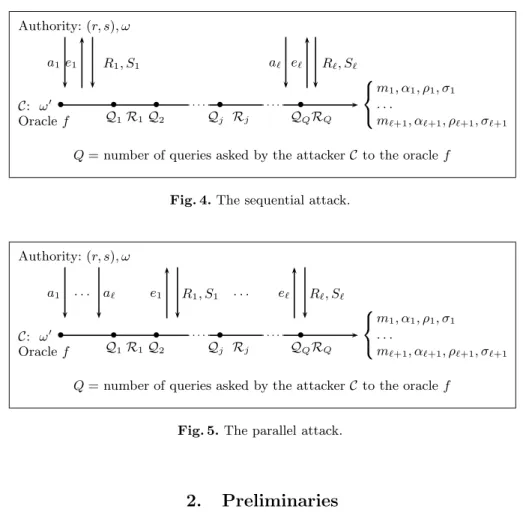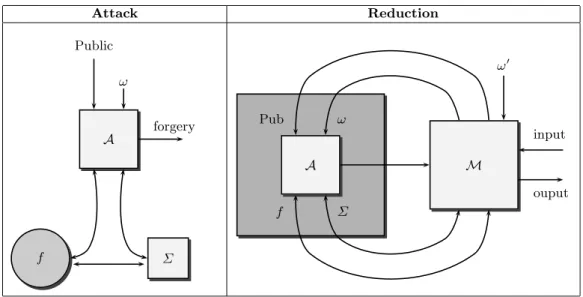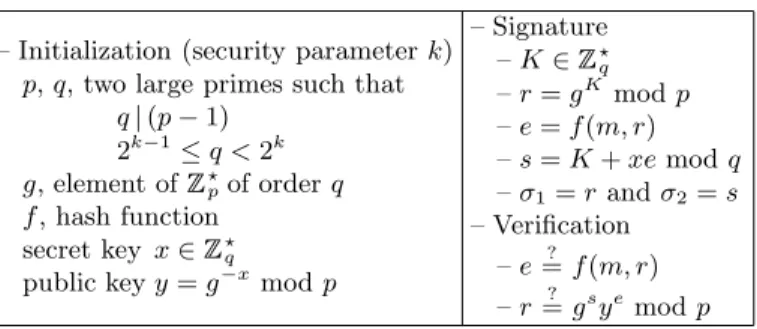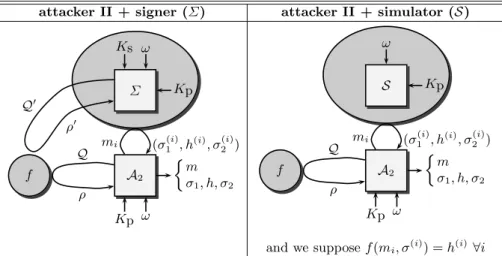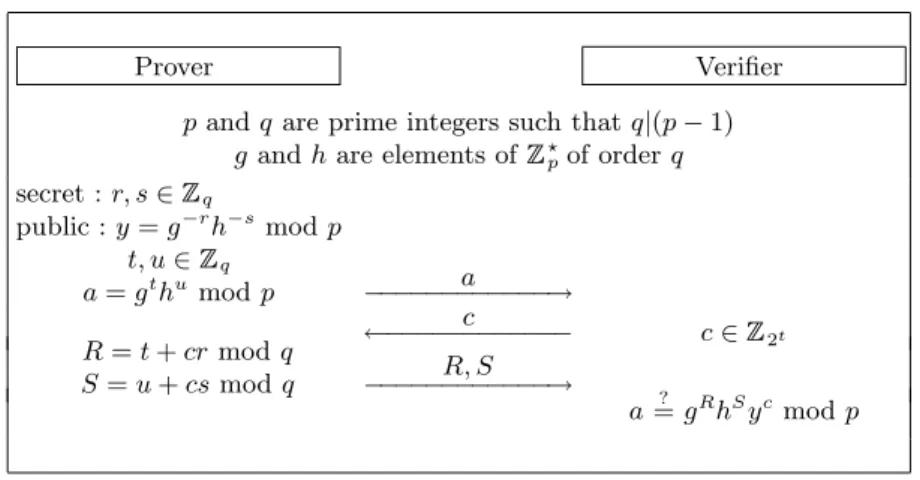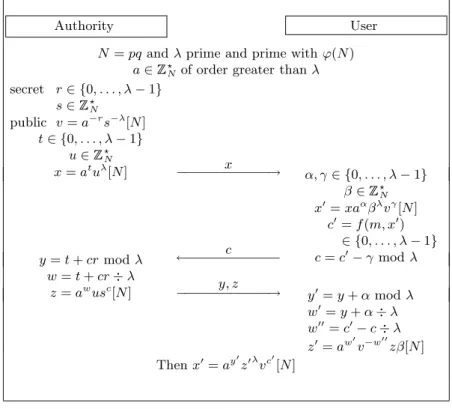2000 International Association for Cryptologic Research
Security Arguments for Digital Signatures and Blind Signatures
?David Pointcheval and Jacques Stern
Laboratoire d’Informatique, ´Ecole Normale Sup´erieure, 75230 Paris Cedex 05, France.
{David.Pointcheval, Jacques.Stern}@ens.fr http://www.di.ens.fr/˜{pointche,stern}
Communicated by Don Coppersmith Received 24 October 1997 and revised 22 May 1998
Abstract. Since the appearance of public-key cryptography in the seminal Diffie- Hellman paper, many new schemes have been proposed and many have been broken.
Thus, the simple fact that a cryptographic algorithm withstands cryptanalytic attacks for several years is often considered as a kind of validation procedure. A much more convincing line of research has tried to provide “provable” security for cryptographic protocols. Unfortunately, in many cases, provable security is at the cost of a consider- able loss in terms of efficiency. Another way to achieve some kind of provable security is to identify concrete cryptographic objects such as hash functions with ideal random objects and to use arguments from relativized complexity theory. The model underlying this approach is often called the “random oracle model.” We use the word “arguments”
for security results proved in this model. As usual, these arguments are relative to well- established hard algorithmic problems such as factorization or the discrete logarithm.
In this paper we offer security arguments for a large class of known signature schemes.
Moreover, we give for the first time an argument for a very slight variation of the well- known El Gamal signature scheme. In spite of the existential forgery of the original scheme, we prove that our variant resists existential forgeries even against an adaptively chosen-message attack. This is provided that the discrete logarithm problem is hard to solve.
Next, we study the security of blind signatures which are the most important ingre- dient for anonymity in off-line electronic cash systems. We first define an appropriate notion of security related to the setting of electronic cash. We then propose new schemes for which one can provide security arguments.
Keywords: Cryptography, Digital signatures, Blind signatures, Security arguments, Existential forgery, One-more forgery, Forking lemma.
?This paper is the full version of “Security Proofs for Signature Schemes” [43] presented at Eurocrypt
’96 and “Provably Secure Blind Signature Schemes” [42] presented at Asiacrypt ’96.
Introduction
Since the beginning of public-key cryptography with the Diffie-Hellman pa- per [16], many new schemes have been proposed and many have been broken.
Thus, the simple fact that a cryptographic algorithm withstands cryptanalytic attacks for several years is often considered as a kind of validation procedure.
In this approach, cryptanalysis is viewed as a heuristic measure of the strength of a new proposal.
A completely different paradigm is provided by the concept of “provable” se- curity. A significant line of research has tried to provide proofs in the asymptotic framework of complexity theory. Stated in a more accurate way, this approach proposes computational reductions to well established problems, such as factor- ization, RSA [49], the discrete logarithm problem or any N P-complete prob- lem [24]. Of course, these are not absolute proofs since cryptography ultimately relies on the existence of one-way functions and the P versus N P question.
Moreover, in many cases, provable security is at the cost of an important loss in terms of efficiency [29],[27],[28],[1].
Recently, the scope of these methods has been considerably widened by us- ing a model where concrete cryptographic objects, such as hash functions, are identified with ideal random objects, the so-called “random oracle model” for- malized by Bellare and Rogaway [2]. In this model, DES [34] is viewed as a random permutation and SHA [36] as a random function with the appropriate range.
Using this model, we offer security arguments for a large class of digital sig- natures. Moreover, we give, for the first time, an argument for a very slight variation of the well-known El Gamal signature scheme [17]. In spite of the exis- tential forgery of the original scheme, we prove that our variant resists existen- tial forgeries even against an adaptively chosen-message attack. This is provided that the discrete logarithm problem is hard to solve. Furthermore, we study the security of blind signatures, especially for their application in electronic cash systems: we first define adequate security notions for blind signatures, then we propose the first schemes for which security arguments can be given.
We now briefly describe the organization of our paper. We first define the so-called “random oracle model” and explain why such a theoretical model can help in proving the validity of the design of a cryptographic scheme. We then recall the definition of a signature scheme together with the various attacks and forgeries that we consider. Also, we present the notion of blind signatures and its use for anonymity (and even revokable anonymity) in electronic cash schemes. Next, we consider the attacks that are relevant in the context of digital payments.
In Section 2, we propose schemes for which one can provide security argu- ments. In order to simplify the proofs, we first explain our generic technique, the “oracle replay attack” and we present a simple probabilistic lemma, the
“splitting lemma.” In Section 3, we prove two fundamental “forking lemma’s”
for digital signatures and blind signatures. They are our main ingredient for providing security arguments for many schemes.
1. Definitions
1.1. The Random Oracle Model
Many cryptographic schemes use a hash function f (such as the Message Digest family MD4 [47], MD5 [48], and derived functions SHA-1 [36], HAVAL [40], RIPEMD [46], or RIPEMD-160 [5]). This use of hash functions was originally motivated by the wish to sign long messages with a single short signature. In order to achieve nonrepudiation, a minimal requirement on the hash function is to ask that it is impossible for the signer to find two different messages providing the same hash value, this property is called collision freeness.
It was later realized that hash functions were an essential ingredient for the security of signature schemes. In order actually to obtain security arguments, while keeping the efficiency of the designs that use hash functions, several authors (e.g. [21], [2],[3], [43], [42] and [44]) have suggested using the hypothesis thatf is actually a random function. We follow this suggestion by using the corresponding model, called the “random oracle model.” In this model the hash function can be seen as an oracle which produces a truly random value for each new query.
Of course, if the same query is asked twice, identical answers are obtained. This is precisely the context of relativized complexity theory with “oracles,” hence the name. It is argued that proofs in this model ensure security of the overall design of a signature scheme provided that the hash function has no weakness.
In the following we replace any hash function by a random oracle which out- puts k-bit long elements, where k is a security parameter of the cryptographic scheme. In other words, k denotes both the security parameter of the crypto- graphic (signature) scheme and the length of the output of the random oracle.
Roughly speaking, the security level is 2k.
1.2. Digital Signature Schemes
We now turn to digital signature schemes, the electronic version of handwritten signatures for digital documents: a user’s signature on a message m is a string which depends onm, on public and secret data specific to the user and–possibly–
on randomly chosen data, in such a way that anyone can check the validity of the signature by using public data only. The user’s public data are called the public key, whereas his secret data are called the secret key. Obviously we would like to prevent the forgery of a user’s signature without knowledge of his secret key. In this section, we give a more precise definition of signature schemes and of the possible attacks against them. These definitions are based on [28].
Definition 1. A signature scheme is defined by the following (see Fig. 1):
– The key generation algorithm G. On input 1k, where k is the security pa- rameter, the algorithm G produces a pair (Kp, Ks) of matching public and secret keys. We denote by n the length of the public key. Algorithm G is probabilistic (with random tape ω).
– The signing algorithm Σ. Given a message m and a pair of matching public and secret keys (Kp, Ks), Σ produces a signature σ. The signing algorithm
Key Generation Signature and Verification
1k G
ω
Ks Kp
V Σ Ks ω
f Kp m σ
OK ? Sizes of objects kis the security parameter Outputs off are of sizek Kp is of lengthn
such thatklogn
Fig. 1.Signature schemes.
might be probabilistic (with random tape ω), and in some schemes it might receive other inputs as well.
– Theverification algorithmV. Given a signatureσ, a messagemand a public key Kp,V tests whether σ is a valid signature of m with respect to Kp. In general, the verification algorithm need not be probabilistic.
1.2.1. Examples
As shown in the Diffie-Hellman paper [16], the trapdoor permutation paradigm allows us to create signatures in the public key setting. Two years later, Rivest et al. [49] proposed the first signature scheme based on the RSA trapdoor function:
The RSA Signature. In the RSA context the generation algorithm produces a large composite number N = pq, a public key e, and a secret key d such that e·d= 1 mod ϕ(N). The signature of a message m is the eth root of m, σ =m1/e =md modN.
The RSA scheme is not secure by itself since it is subject to existential forgery.
In other words, it is easy to create a valid message-signature pair, without any help of the signer, using the public verification relationm =σe modN. In many cases, this is not really dangerous because the resulting message is not intelligible or does not have the proper redundancy. Still such an RSA signature does not prove by itself the identity of the sender.
In 1986 a new paradigm for signature schemes was introduced. It is derived from fair zero-knowledge identification protocols involving a prover and a ver- ifier [26], and uses hash functions in order to create a kind of virtual verifier.
In [21], Fiat and Shamir proposed a zero-knowledge identification protocol based on the hardness of extracting square roots. They also described the correspond- ing signature scheme and outlined its security. Similar security results for other signature schemes like Schnorr’s [50], [51] are considered folklore results but have
never appeared in print. We refer the reader to the literature for the precise de- scription of those schemes, and we only recall the Schnorr signature:
The Schnorr Signature.The generation algorithm produces two large primesp and q, such that q ≥ 2k, where k is the security parameter, and q|p−1, as well as an element g of ?p of order q. It also creates a pair of keys, x∈ ?q and y=g−x modp. The signer publishes y and keeps x secret. The signa- ture of a message m is a triple (r, e, s), where r=gK mod p, with a random K ∈ ?q, the “challenge” e=H(m, r) mod q and s =K+ex mod q. It satis- fies r=gsye mod p with e =H(m, r), or simply e=H(m, gsye mod p), which is checked by the verifying algorithm.
1.2.2. Generic Digital Signature Schemes
In this paper we consider signature schemes which, given the input message m, produce triples (σ1, h, σ2) where σ1 randomly takes its values in a large set, his the hash value of (m, σ1) and σ2 only depends on σ1, the message m, and h.
In particular, we can remark that each signature is independent of the previ- ous ones. More precisely, in the proof of resistance against the strongest at- tacks, we assume that no σ1 can appear with probability greater than 2/2k, where k is the security parameter. This assumption is satisfied in the Schnorr signature scheme: σ1 =gK modp for a randomly chosen K in ?q; since g is of order q, and k ≤logq, the probability for σ1 to get a specific value is less than 1/(q−1)≤2/2k. In the same way, the Fiat-Shamir [21] scheme and many others also satisfy this assumption.
In some cases, in order to optimize the size of signatures, σ1 or h can be omitted, since they can be correctly recovered during the verification process.
For notational purposes we ignore these possible optimizations and keep σ1, h as parts of the signature.
1.2.3. Attacks
We focus on two specific kinds of attacks against signature schemes: the no- message attack and theknown-message attack. In the first scenario, the attacker only knows the public key of the signer. In the second one, the attacker has access to a list of message-signature pairs. According to the way this list was created, we distinguish four subclasses of known-message attacks:
– The plain known-message attack: the attacker has access to a list of signed messages, but he has not chosen them.
– The generic chosen-message attack: the attacker can choose the list of mes- sages to be signed. However this choice must be made before accessing the public key of the signer. We call this attack “generic” because the choice is independent of the signer.
– The oriented chosen-message attack: as above, the attacker chooses the list of messages to be signed, but the choice is made once the public key of the signer has been obtained. This attack is oriented against a specific signer.
no-message adaptively chosen-message
attack attack
A1
Kp ω f m, σ
Q
ρ
A2
Kp ω m σ1, h, σ2
f
Q ρ
Σ Ks ω
Kp Q0
ρ0
mi (σ(i)1 , h(i), σ2(i))
Fig. 2.Attacks.
– Theadaptively chosen-message attack: having knowledge of the public key of the signer, the attacker can ask the signer to sign any message that he wants.
He can then adapt his queries according to previous message-signature pairs.
In the following we only consider the two extreme scenarios, the no-message attack and the adaptively chosen-message attack (see Fig. 2).
1.2.4. Forgeries
We now classify the expected results of an attack:
– Disclosing the secret key of the signer. It is the most serious attack. This attack is termed total break.
– Constructing an efficient algorithm which is able to sign any message. This is called universal forgery.
– Providing a new message-signature pair. This is called existential forgery.
In many cases this attack is not dangerous, because the output message is likely to be meaningless. Nevertheless, a signature scheme which is not existentially unforgeable does not guarantee by itself the identity of the signer. For example, it cannot be used to certify randomly looking elements, such as keys.
Definition 2. (Secure Signature Scheme). A signature scheme issecure if an ex- istential forgery is computationally impossible, even under an adaptively chosen- message attack.
The first secure signature scheme was proposed by Goldwasser et al. [27] in 1984. It uses the notion of claw-free permutations pairs: informally, these are permutations f0 and f1 over a common domain for which it is computation- ally infeasible to find a triple (x, y, z) such thatf0(x) =f1(y) = z. Furthermore, Goldwasser et al. proved that such “claw-free” permutations pairs exist if fac- toring is hard (see [27] and [28] for details).
Bank
User Shop
withdrawal deposit
spending
Fig. 3.Coin life.
1.3. Blind Signatures
After this brief outline of signature schemes, we review another cryptographic primitive: blind signatures. We first motivate their use and give some well-known examples. We then define specific security properties of blind signatures related to the setting of electronic cash.
1.3.1. Motivation: Electronic Cash
As early as 1982, Chaum’s [13] pioneering work aimed at creating an electronic version of money. To achieve this goal, he introduced the notions of “coins”
and “randomized blind signatures” (or simply “blind signatures”). He claimed that this was the only way to ensure the required anonymity: in real life, a coin cannot be easily traced from the bank to the shop, furthermore, two spendings of a same user cannot be linked together. These are two main properties of real coins that Chaum wanted to mimic: untraceability and unlinkability.
He proposed to define an electronic coin as a number with a certificate (a signature) produced by the bank; it is withdrawn from the bank, spent by the user, and deposited by the shop (see Fig. 3).
On-line electronic cash. In his first scheme, Chaum used blind signatures for the production of coins. The user makes the bank blindly sign a coin. Then the user is in possession of a valid coin that the bank itself cannot recognize nor link with the user. When the user spends the coin, the shop immediately returns it to the bank. If the coin has already been spent, the bank detects the fact and informs the shop so that it refuses payment. It is an “on-line” context: there is a continuous communication between the shop and the bank in order to verify the validity of coins. In order to define the scheme, Chaum introduced the first blind signature scheme, based on the RSA hypothesis. It is a by now classical transformation of the original RSA signature scheme [49]:
The Blind RSA Signature. The bank has a large composite numberN =pq, a public key e, and a related secret key d. It also uses a public hash functionH.
In order to get the signature of a random number ρ, the user “blinds” it with a random value re mod N, and sends m=H(ρ)re mod N to the signer. The latter returns a signature σ0 of msuch thatσ0e =m =reH(ρ) mod N. Then the
user can “unblind” this signature computing σ=σ0r−1 mod N. A coin is any pair (ρ, σ) which satisfies σe =H(ρ) mod N.
In this scheme all coins have the same value, but in a real system different denominations might be encoded by different exponents e.
Off-line electronic cash and the “cut-and-choose” methodology. In an “off-line”
context we cannot prevent a user from spending a coin twice or even more, since the detection is made too late to refuse payment. This fraud is called “double- spending.” We only can hope that the double-spender will be discovered later and punished. Chaum et al. [14] were able to build such schemes by introducing the identity of the user in the coin in such a way that it remains concealed, unless double-spending happens. Once, blind signatures were a critical point for anonymity, and, as before, the authors used the blind RSA signature, together with the “cut-and-choose” technique: in their proposition, a coin is a kind of list of k blind signatures, each having an embedded copy of the identity of the user. To be sure that double-spending will reveal the real identity of the user, the bank would like to verify that the signatures actually have the requested format, which would revoke anonymity. Then the bank helps the user to get 2k signatures, randomly chooses k of them, and verifies the inner structure of the selected signatures. Since these signatures are no longer anonymous, the user throws them away and constructs the coin with thekother ones. The probability for a cheater to be finally in possession of a fraudulous coin is about 2−2k.
The main drawback of the “cut-and-choose” technique is that the coins are very large, as well as the amount of computations. In 1993 Ferguson [20] and Brands [7] proposed new schemes without “cut-and-choose.” The first one uses once again the blind RSA signature, whereas Brands’ scheme uses a new blind signature derived from the Schnorr signature scheme [50], [51]:
The Blind Schnorr Signature. The generation algorithm produces two large prime integers p and q such that q|p−1 as well as an element g of ?p of or- der q. It also creates a pair of keys, (x, y), where x∈ ?q is the secret one, and y =g−x modp is the public one. The signer publishes y. In order to get the signature of a secret message m, the user asks the signer to initiate a com- munication. He chooses a random K ∈ ?q, computes and sends the “commit- ment” r=gK modp. The user then blinds this value with two random elements α, β ∈ q, into r0 =rg−αy−β mod p, computes the value e0 =H(m, r0) mod q and sends the “challenge”e=e0 +β modqto the signer who returns the values such that gsye =r modp. Finally, the user computes s0 =s−α mod q. This
way, the pair (e0, s0) is a valid Schnorr signature ofmsince it satisfiese0 =H(m, gs0ye0 mod p).
In both schemes Ferguson and Brands managed to hide the identity of the user in a much more efficient way than the “cut-and-choose” methodology.
Again, the identity is revealed after double-spending. Those blind signatures which hide a specific structure, such as the identity, are called “restrictive blind signatures” [11], [9], [8], [45]. Many extensions [19], [6], [10] have been proposed, followed by some attacks [8], [11] and repairs [9], [52]. All of them use blind signatures, and the security of the proposed schemes is totally dependent on the
security of the blind signatures they use. Surprisingly, no security proofs have been proposed so far for blind signatures.
Revokable Anonymity A few years ago [57], an undesirable feature of total anonymity in transactions was considered: perfect crimes (anonymous crimes without leaving any traces and consequently without any risk of being suspected later). Accordingly, a new line of research in electronic cash has investigated “re- vokable anonymity” [12], [22], [31] which proposes anonymity unless a Trusted Third Party (TTP) partially revokes it for some established reasons or in view of an obvious fraud (e.g. in case of double-spending). Again, those new schemes rely on the security of blind signature schemes.
1.3.2. Security
As far as we know, no formal notion of security has ever been studied, or proved, in the context of blind signatures. However, it is a critical point in electronic cash systems. In the context of blind signatures, the previous definitions of security are no longer significant. In fact, existential forgery is somehow the basis for blind signatures. Nevertheless, a fundamental property for electronic cash systems is the guarantee that a user cannot forge more coins than the bank gives him. In other words, with ` blind signatures of the Bank, the user must not be able to create more than ` coins. This form of security was more or less informally assumed in connection with several schemes, for example in [10], or under the
“unexpandability” property of [23].
Definition 3 (The(`, `+ 1)-Forgery).For any integer`, an (`, `+ 1)-forgery comes from an attacker that produces `+ 1 signatures after` interactions with the signer Σ.
Definition 4 (The “One-More” Forgery). For some integer `, polynomial in the security parameter k, an attacker can obtain `+ 1 valid signatures after fewer than ` interactions with the signer. In other words, a “one-more forgery”
is an (`,`+ 1)-forgery for some polynomially bounded integer`.
Definition 5 (The Strong “One-More” Forgery). An (`, `+ 1)-forgery for a polylogarithmically bounded integer ` (i.e., for some constant α,`≤(logk)α, where k is the security parameter) is called a strong “one-more” forgery.
As usual, several scenarios can be envisioned. We focus on two kinds of attacks which naturally come from the use of blind signatures in electronic cash : – The sequential attack (see Fig. 4): the attacker interacts sequentially with the signer. This attack can be performed by a user who withdraws coins, one after the other.
It is clear that, in practical situations, many users might be allowed to with- draw money at the same time. The following attack must then be considered.
– Theparallel attack (see Fig. 5): the attacker interacts`times in parallel with the signer. This attack is stronger. Indeed, the attacker can initiate new interactions with the signer before previous ones have ended. This attack can be performed by a group of users who withdraw many coins at the same time.
• • • • • Authority: (r, s), ω
C: ω0
Oraclef Q1R1Q2 Qj Rj QQRQ
a1 e1 R1, S1 a` e` R`, S`
m1, α1, ρ1, σ1
. . .
m`+1, α`+1, ρ`+1, σ`+1
Q= number of queries asked by the attackerC to the oraclef
Fig. 4.The sequential attack.
• • • • •
Authority: (r, s), ω
C: ω0
Oraclef Q1R1Q2 Qj Rj QQRQ
a1 . . . a` e1 R1, S1 . . . e` R`, S`
m1, α1, ρ1, σ1
. . .
m`+1, α`+1, ρ`+1, σ`+1
Q= number of queries asked by the attackerC to the oraclef
Fig. 5.The parallel attack.
2. Preliminaries
2.1. Complexity Theory and “Oracle Replay Attack”
In this paper we offer several security arguments for digital signatures and blind signatures. All our results are given in the context of complexity theory. Hence, any participant is modeled by a probabilistic polynomial time Turing machine.
Our paradigm is to use a supposedly efficient attacker in order to solve a difficult algorithmic problem. This goes through a generic reduction technique (see Fig. 6) which we call the oracle replay attack (see Fig. 7): by a polynomial replay of the attack with different random oracles (the Qi’s are the queries and the ρi’s are the answers), we make the attacker successfully forge signatures which are suitably related. More precisely, we want to obtain two signatures (σ1, h, σ2) and (σ10, h0, σ20) of an identical message m such that σ1 =σ10, but h 6= h0. We then extract the solution of a difficult problem from the ability to forge such pairs.
In the reductions, an important problem is to simulate properly the interactions that the attacker should have with other entities (with the random oracle f and particularly with the signer Σ). Those simulations should be indistinguishable from real interactions from the point of view of the attacker despite the obvious fact that no secret key is available.
2.2. Distinguishability of Distributions of Probability
As explained above, in our reductions, we have to provide indistinguishable sim- ulations: the communication tapes between the attacker and the simulator and
Attack Reduction
A
Σ Public
ω
f
forgery
M A
Σ f
Pub ω
ω0
input
ouput
Fig. 6.Reduction of a difficult problem.
between the attacker and the signer (for example) will have to follow indistin- guishable distributions of probability. In this subsection we define two notions of indistinguishability.
Recall that a function f(k) is negligible in k if, for every polynomial p, f(k) is smaller than 1/|p(k)|, for k large enough; otherwise, it is nonnegligible.
Definition 6. Letδ0 and δ1 be two distributions of probability. Adistinguisher Dis a probabilistic polynomial time Turing machine, with random tapeω, which, on input ρ, answers 0 or 1.
The advantage of D with respect to two distributions δ0 and δ1 is defined as Adv(D, δ0, δ1) = 12 × E
ρ∈δ0
[D(ω, ρ)]− E
ρ∈δ1
[D(ω, ρ)]. It is easy to derive the following equality:
Pr
ω c∈{0,1}
ρ∈δc
[D(ω, ρ) =c] = 12 ±Adv(D, δ0, δ1).
So, if this advantage is negligible, the answer of the distinguisher looks like the result of flipping a coin.
ωQ•1
ρ1 Q•2
Q•β
2k answers ρβ Qβ+1•
Q•Q
ρQ (Qβ, ρβ, σ)
ρ0β •
Q0β+1 • Q0Q
ρ0Q
(Qβ, ρ0β, σ0)
Fig. 7.The oracle replay attack.
Two distributions δ0 and δ1 are polynomially indistinguishable if there does not exist any distinguisher D with a nonnegligible advantage.
Two distributions δ0 and δ1 are statistically indistinguishable if X
y
x∈δPr0[x=y]− Pr
x∈δ1[x=y] is negligible.
Remark 1. It is clear that if two distributions are statistically indistinguishable, they are polynomially indistinguishable.
2.3. The Splitting Lemma
Throughout this paper we repeatedly use the “Splitting Lemma” below. It trans- lates the fact that when a subset A is “large” in a product space X×Y, it has many “large” sections.
Lemma 1. (The Splitting Lemma). LetA⊂X×Y such thatPr[(x, y)∈A]≥ε.
For any α < ε, define B =
(x, y)∈X×Y Pr
y0∈Y[(x, y0)∈A]≥ε−α
and B¯ = (X×Y)\B, then the following statements hold:
(i) Pr[B]≥α
(ii) ∀(x, y)∈B,Pry0∈Y[(x, y0)∈A]≥ε−α.
(iii) Pr[B|A]≥α/ε.
Proof. In order to prove statement i), we argue by contradiction.
Assume that Pr[B]< α. Then
ε ≤ Pr[B]·Pr[A|B] + Pr[ ¯B]·Pr[A|B]¯ < α·1 + 1·(ε−α) = ε.
This implies a contradiction, hence the result.
Statement (ii) is a straightforward consequence of the definition.
We finally turn to the last assertion, using Bayes’ law:
Pr[B|A] = 1−Pr[ ¯B|A]
= 1−Pr[A|B]¯ ·Pr[ ¯B]/Pr[A]≥1−(ε−α)/ε=α/ε.
u t
3. Security Arguments for Digital Signatures
This section is devoted to digital signatures and extends our previous results on their security [43]. Recall that an identification scheme [21] is an interactive protocol which involves a prover and a verifier. The prover tries to convince the verifier of his knowledge of a secret related to his identity. More specifically, a three-pass honest-verifier zero-knowledge identification protocol is an identifica- tion scheme with three interactions between the prover and the verifier, which leaks no information about the secret provided the verifier plays honestly, namely
randomly choosing his queries. The three interactions correspond to three mes- sages: the “commitment”asent by the prover, the “challenge”erandomly chosen by the verifier, and the “answer” r of the prover. The verifier finally accepts the proof if and only if this triple satisfies a test V(a, e, r) = 1. As described by Fiat and Shamir [21], any three-pass honest-verifier zero-knowledge identifica- tion protocol can be turned into a generic digital signature scheme: let (a, e, r) be a round of the identification protocol, we get a digital signature scheme by replacing the query of the verifier, which is a random value e, by the hash value of the message m to be signed together with the commitmenta which is bound not to change, namely, e=f(m, a), wheref is the hash function. If the identifi- cation protocol needs several sequential iterations in order to reach an adequate level of security, then, in the signature setting, one parallelizes the protocol. Ac- cordingly, a signature of a message m is a triple (σ1, h, σ2), where σ1 represents all successive “commitments” of the parallelized protocol, h = f(m, σ1) and σ2 represents all successive “answers” of the parallelized protocol. It satisfies a test V(σ1, h, σ2) = 1 as described above in the generic digital signature schemes section (see Section 1.2.2.). For example, the Schnorr signature scheme is pre- cisely the result of the above transformation applied to the Schnorr identification protocol.
In what follows, we assume that f outputs k-bit long elements, where k is the security parameter of the signature scheme, as described above.
We first prove the security of a generic digital signature scheme against no- message attacks. As an application, we directly obtain the security of the Schnorr signature scheme. Next, we extend our result to the adaptively chosen-message context. We close the section with a study of the El Gamal signature scheme [17]:
in spite of the existential forgery of the original scheme, we present a slight variation which is existentially unforgeable under an adaptively chosen-message attack. This is provided that the discrete logarithm problem is hard to solve.
3.1. No-Message Attacks
In this part we consider the no-message scenario. We propose a generic result and we apply our technique to the Schnorr signature scheme.
3.1.1. Generic Results
Lemma 2. Let (G, Σ, V) be a generic digital signature scheme with security parameter k. Let A be a probabilistic polynomial time Turing machine whose input only consists of public data and which can ask Q queries to the random oracle, with Q > 0. We assume that, within the time bound T, A produces, with probability ε≥7Q/2k, a valid signature (m, σ1, h, σ2). Then, within time T0 ≤16QT /ε, and with probability ε0 ≥ 19, a replay of this machine outputs two valid signatures (m, σ1, h, σ2) and (m, σ1, h0, σ02) such that h6=h0.
Proof. We start with a no-message attacker A, which is a probabilistic polyno- mial time Turing machine with random tapeω. During the attack, this machine asks a polynomial number of questions to the random oraclef. We may assume
that these questions are distinct: for instance,Acan store questions and answers in a table. Let Q1, . . . ,QQ be the Q distinct questions and letρ = (ρ1, . . . , ρQ) be the list of the Q answers of f. It is clear that a random choice of f exactly corresponds to a random choice of ρ. Then, for a random choice of (ω, f), with probability ε, A outputs a valid signature (m, σ1, h, σ2). Since f is a random oracle, it is easy to see that the probability for h to be equal to f(m, σ1) is less than 1/2k, unless it has been asked during the attack. So, it is likely that the question (m, σ1) is actually asked during a successful attack. Accordingly, we define Ind(ω, f) to be the index of this question: (m, σ1) = QInd(ω,f) (we let Ind(ω, f) =∞ if the question is never asked). We then define the sets
S={(ω, f)| Af(ω) succeeds & Ind(ω, f)6=∞},
and Si={(ω, f)| Af(ω) succeeds & Ind(ω, f) =i} for i∈ {1, . . . , Q}.
We call S the set of the successful pairs (ω, f), and we note that the set {Si|i∈ {1, . . . , Q}} is a partition of S. With those definitions, we find a lower bound for the probability of success, ν = Pr[S] ≥ ε−1/2k ≥ 6ε/7. Let I be the set consisting of the most likely indices i, I ={i Pr[Si| S]≥1/2Q}. The following lemma claims that, in case of success, the index lies in I with proba- bility at least 12.
Lemma 3. Pr[Ind(ω, f)∈I S]≥ 12.
Proof. By definition of the sets Si, Pr[Ind(ω, f)∈I| S] =P
i∈IPr[Si| S]. This probability is equal to 1−P
i6∈IPr[Si| S]. Since the complement of I contains fewer than Q elements, this probability is at least 1−Q×1/2Q≥ 12. ut We now run the attacker 2/ε times with random ω and random f. Since ν = Pr[S] ≥6ε/7, with probability greater than 1−(1−6ε/7)2/ε, we get at least one pair (ω, f) in S. It is easily seen that this probability is lower bounded by 1−e−12/7 ≥ 45.
We now apply the Splitting-lemma (lemma 1) for each integer i∈I: we denote by fi the restriction of f to queries of index strictly less than i. Since Pr[Si]≥ν/2Q, there exists a subset Ωi of executions such that,
for any (ω, f)∈Ωi, Prf0[(ω, f0)∈ Si|fi0 =fi]≥ν/4Q Pr[Ωi| Si]≥ 12. Since all the subsets Si are disjoint,
Prω,f[(∃i∈I) (ω, f)∈Ωi ∩ Si| S]
= Pr
"
[
i∈I
(Ωi∩ Si)| S
#
=X
i∈I
Pr[Ωi∩ Si| S]
=X
i∈I
Pr[Ωi| Si]·Pr[Si| S]≥ X
i∈I
Pr[Si| S]
!
/2≥ 14. We let β denote the index Ind(ω, f) corresponding to the successful pair.
With probability at least 14, β ∈I and (ω, f) ∈ Sβ ∩Ωβ. Consequently, with
probability greater than 15, the 2/εattacks have provided a successful pair (ω, f), with β =Ind(ω, f)∈I and (ω, f)∈ Sβ. Furthermore, if we replay the attack, with fixed ω but randomly chosen oracle f0 such that fβ0 = fβ, we know that Prf0[(ω, f0)∈ Sβ|fβ0 =fβ]≥ν/4Q. Then
Prf0[(ω, f0)∈ Sβ and ρβ 6=ρ0β|fβ0 =fβ]
≥Pr
f0[(ω, f0)∈ Sβ|fβ0 =fβ]−Pr
f0[ρ0β =ρβ]≥ν/4Q−1/2k≥ε/14Q, where ρβ =f(Qβ) and ρ0β =f0(Qβ). We us replay the attack 14Q/ε times with a new random oracle f0 such thatfβ0 =fβ. With probability greater than 35, we get another success.
Finally, after less than 2/ε+ 14Q/εrepetitions of the attack, with probability greater than 15 × 35 ≥ 19, we have obtained two valid signatures (m, σ1, h, σ2) and (m0, σ01, h0, σ20) withQβ = (m, σ1) = (m0, σ10) and distinct challengesh=f(Qβ)6=
f0(Qβ) = h0. ut
The careful reader has noticed that the mechanics of our reduction depend on some parameters related to the attacker A, namely, its probability of suc- cess ε and the number Qof queries to the random oracle. This induces a lack of uniformity. In order to overcome this problem, we can use the reduction tech- nique presented in our previous Eurocrypt ’96 paper [43]. Unfortunately, the probability of success of the resulting reduction is much smaller: the expected time of success is of the order of Q4/ε3 instead of Q/ε. Accordingly, we end up extremely far from any form of the “exact security” concept [3].
It is better to see the resulting machine Mas an expected polynomial time Turing machine:
1. M initializes j = 0;
2. M runs A until it outputs a successful pair (ω, f)∈ S and denotes by Nj
the number of calls toAto obtain this success, and byβ the indexInd(ω, f);
3. Mreplays, at most 140Njαj times,Awith fixedω and randomf0 such that fβ0 =fβ, where α= 87;
4. M increments j and returns to 2, until it gets a successful forking.
For any execution of M, we denote by J the last value of j and by N the total number of calls to A. We want to compute the expectation of N. Since ν = Pr[S], and Nj ≥ 1, then Pr[Nj ≥1/5ν]≥ 34. We define `=dlogαQe, so that, 140Njαj ≥28Q/ε for any j ≥ `, whenever Nj ≥ 1/5ν. Therefore, for any j ≥ `, when we have a first success in S, with probability greater than 14, the index β =Ind(ω, f) is in the set I and (ω, f)∈ Sβ ∩Ωβ. Furthermore, with probability greater than 34, Nj ≥ 1/5ν. Therefore, with the same conditions as before, that is ε≥7Q/2k, the probability of getting a successful fork after at most 28Q/ε iterations at step 3 is greater than 67.
For any t ≥ `, the probability for J to be greater or equal to t is less than (1− 14 × 34 × 67)t−`, which is less than γt−`, with γ = 67. Furthermore,
E[N|J =t]≤
j=t
X
j=0
E[Nj] + 140E[Nj]αj
≤ 141 ν ×
j=t
X
j=0
αj ≤ 141
ν × αt+1 α−1.
– Initialization (security parameterk) p,q, two large primes such that
q|(p−1) 2k−1≤q <2k g, element of ?pof orderq f, hash function
secret key x∈ ?q
public keyy=g−xmodp
– Signature –K∈ ?q
–r=gK modp –e=f(m, r) –s=K+xemodq –σ1=randσ2=s – Verification
–e=? f(m, r) –r=? gsyemodp
Fig. 8.The Schnorr signature scheme.
So, the expectation of N is E[N] =P
tE[N|J =t]·Pr[J =t] and then is
≤ 141
ν ×X
t
αt+1 α−1
×Pr[J ≥t]
≤ 165 ε ·
"t=`−1 X
t=0
αt+1 α−1
+X
t≥`
αt+1 α−1
×γt−`
#
≤ 165
ε · α`+1 α−1 ·
"
1
α−1 +X
t
(αγ)t
#
≤ 165
ε · α`+1 α−1 ·
1
α−1 + 1 1−αγ
.
Using the definition of ` and the values of α and γ, we obtain E[N]≤ 165
ε · 64Q
7 ·(7 + 49) = 84480Q
ε .
Hence the following theorem.
Theorem 1. (The Forking Lemma). Let (G, Σ, V) be a generic digital signa- ture scheme with security parameter k. Let A be a probabilistic polynomial time Turing machine whose input only consists of public data. We denote by Q the number of queries that Acan ask to the random oracle. Assume that, within time bound T, Aproduces, with probabilityε ≥7Q/2k, a valid signature(m, σ1, h, σ2).
Then there is another machine which has control over A and produces two valid signatures (m, σ1, h, σ2) and (m, σ1, h0, σ20) such that h 6= h0, in expected time T0 ≤84480T Q/ε.
3.1.2. The Schnorr Digital Signature Scheme
We now apply the previous result in the simple setting of the Schnorr signature scheme (see Fig. 8).
Firstly, we briefly describe the protocol. For any security parameter k, an authority chooses two large prime integers p and q, such that 2k−1 ≤q <2k holds and q divides p −1 as well as an element g from ?p of order q. The triple (p, q, g) is published together with a public hash function f whose output
domain is identified to ?q. The security parameter k is then equal to dlogqe, whereas the size of the public key, denoted byn, is equal todlogpe. Furthermore, we assume that k logn. Any user randomly chooses his secret key x in ?q, and publishes y=g−x mod p.
In order to sign a messagem, the user chooses a random elementK in ?qand computes the commitmentr=gK mod p. He gets the challengee=f(m, r) and computes s =K+xe modq. The signature is the triple (r, e, s), which satisfies the tests r =? gsye mod pand e =? f(m, r).
Theorem 2. Assume that, within a time bound T, an attacker A performs an existential forgery under a no-message attack against the Schnorr signature, with probability ε ≥7Q/q. We denote by Q the number of queries that A can ask to the random oracle. Then the discrete logarithm in subgroups of prime order can be solved in expected time less than 84480QT /ε.
Proof. As we have previously seen, this scheme satisfies all the required prop- erties of a generic signature scheme. From the Forking Lemma (Theorem 1), after a polynomial replay of the attacker A, we obtain two valid signatures (m, r, e, s) and (m, r, e0, s0) with e6=e0. Then we have the following equalities r =gsye modp and r =gs0ye0 modp, from which we obtain the discrete loga-
rithm loggy= (s−s0)/(e0−e) mod q. ut
3.2. Adaptively Chosen-Message Attacks
We now focus on the adaptively chosen-message scenario. As in the previous section, we first give a generic result and we apply the technique to the Schnorr signature scheme.
3.2.1. Generic Results
As was previously observed, in a no-message scenario, only the least powerful kind of adversaries is assumed to attack the signature scheme. For many ap- plications, resistance to this type attack is not considered sufficient. If we want to assess the “security” of a signature scheme, we should prove its resistance against adaptively chosen-message attacks. In such a scenario, the attacker uses the signer as an oracle, and asks any signature he wants. If it is possible to simulate the signer Σ by a simulator S who does not know the secret key (see Fig. 9), then we can make the attacker and the simulator collude in order to break the signature scheme, and, the same way as before, we can obtain two distinct signatures with a suitable relation.
Lemma 4. Let A be a probabilistic polynomial time Turing machine whose in- put only consists of public data. We denote respectively byQandRthe number of queries thatAcan ask to the random oracle and the number of queries thatAcan ask to the signer. Assume that, within a time bound T, A produces, with prob- ability ε≥10(R+ 1)(R+Q)/2k, a valid signature (m, σ1, h, σ2). If the triples (σ1, h, σ2)can be simulated without knowing the secret key, with an indistinguish- able distribution probability, then, a replay of the attacker A, where interactions
attacker II + signer (Σ) attacker II + simulator (S)
A2
Kp ω m σ1, h, σ2
f
Q ρ
Σ Ks ω
Kp Q0
ρ0
mi (σ(i)1 , h(i), σ2(i))
A2
Kp ω m σ1, h, σ2
f
Q ρ
S ω
Kp
mi (σ(i)1 , h(i), σ2(i))
and we supposef(mi, σ(i)) =h(i) ∀i
Fig. 9.Adaptively chosen message scenario.
with the signer are simulated, outputs two valid signatures (m, σ1, h, σ2) and (m, σ1, h0, σ20) such that h 6= h0, within time T0 ≤23QT /ε and with probability ε0 ≥ 19.
Proof. As in the previous proof, we letQ1, . . . ,QQ denote theQdistinct queries to the random oracle, ρ1, . . . , ρQ the respective answers, and m1, . . . , mR the R queries (possibly all the same) to the signing oracle. Using the simulator, we can simulate the answers of the signer without knowledge of the secret key. For a message mi, the simulator answers a triple (σ(i)1 , h(i), σ2(i)). Then, the attacker assumes that f(mi, σ1(i)) =h(i) and stores it. The previous proof can be exactly mimicked, except for the problem added by the simulations: there is some risk of “collisions” of queries, or supposed queries, to the random oracle. Recall that in the definition of generic digital signature schemes, we made the assumption that the probability for a “commitment” σ1(i) to be output by the signing oracle is less than 2/2k. Then, two kinds of collisions can appear:
– A pair (mi, σ1(i)) that the simulator outputs also appears in the list of ques- tions asked to the random oracle by the attacker (some question Qj). The probability of such an event is less than QR×2/2k ≤ε/5.
– A pair (mi, σ1(i)) that the simulator outputs is exactly similar to another pair produced by this simulator (some question (mj, σ1(j))). The probability of such an event is less than R2/2×2/2k ≤ε/10.
Altogether, the probability of collisions is less than 3ε/10. Therefore, Prω,f[A succeeds and no-collisions]
≥Pr
ω,f[A succeeds]−Pr
ω,f[collisions] ≥ ε(1− 103) ≥ 7ε/10.
This is clearly greater than 7Q/2k. We can then apply the previous Forking Lemma (lemma 2). Such a replay succeeds with probability ε0 ≥ 19, within time
T0 ≤16QT ×10/7ε ≤23QT /ε. ut
Theorem 3 (The Forking Lemma). LetA be a probabilistic polynomial time Turing machine whose input only consists of public data. We denote respectively by Q and R the number of queries that A can ask to the random oracle and the number of queries that A can ask to the signer. Assume that, within a time bound T, A produces, with probability ε≥10(R+ 1)(R+Q)/2k, a valid signa- ture (m, σ1, h, σ2). If the triples (σ1, h, σ2) can be simulated without knowing the secret key, with an indistinguishable distribution probability, then there is another machine which has control over the machine obtained from A replacing interac- tion with the signer by simulation and produces two valid signatures(m, σ1, h, σ2) and (m, σ1, h0, σ02) such that h6=h0 in expected time T0 ≤120686QT /ε.
Proof. The collusion of the attacker A and the simulatorS defines a machine B which performs a no-message attack. An execution ofBis successful if it outputs a forgery, and if there is no collisions of queries to the random oracle during the process. Then, within a time bound T, B has a probability of success greater than 7ε/10 ≥ 7Q/2k. Using Theorem 1, within an expected number of steps bounded by 84480Q/(7ε/10), one can provide two valid signatures. ut 3.2.2. Application to the Schnorr Digital Signature Scheme
Theorem 4. Let A be an attacker which performs, within a time bound T, an existential forgery under an adaptively chosen-message attack against the Schnorr signature, with probability ε. We denote respectively by Q and R the number of queries that Acan ask to the random oracle and the number of queries that A can ask to the signing oracle. Assume thatε ≥10(R+ 1)(R+Q)/q, then the discrete logarithm in subgroups of prime order can be solved within expected time less than 120686QT /ε.
Proof. We only have to prove that the triples (r, e, s) produced by the signer and the random oracle can be simulated without the knowledge of the signer’s secret. Once this is done, the result directly follows from Theorem 3, using the same proof as for Theorem 2.
Lemma 5. The following distributions are the same:
δ =
(r, e, s)
K ∈R ?q e ∈R q r=gK mod p s=K+xe mod q
and δ0 =
(r, e, s)
K ∈R q
e∈R q s =K r =gsye mod p
r6= 1 mod p
.
Proof. First we choose a triple (ε, β, γ) from the set of the signatures: letε∈ ?p, γ ∈ q and β∈ q such that gγyβ =ε6= 1 mod p. We then compute the proba- bility of appearance of this triple following each distribution of probabilities:
Prδ [(r, e, s) = (ε, β, γ)] = Pr
K6=0,e
gK =ε;e=β K +xe=γ
= 1
q(q−1) Prδ0[(r, e, s) = (ε, β, γ)] = Pr
r,e
ε =r =gKye
e=β;s=K =γ r6= 1 mod p
= 1
q(q−1).
u t From the above, the following simulator S produces triples (r, e, s) with an identical distribution from those produced by the signer. In order to sign the message m,S randomly choosese∈ q and K ∈R q, and sets r=gKye mod p ands =K. In the (unlikely) situation wherer= 1 mod p, we discard the results and restart the simulation. Then it returns the triple (r, e, s). ut 3.2.3. Further Results
It is clear that identical results can be obtained for any signature scheme which is the transformation of a honest-verifier zero-knowledge identification protocol, and a fortiori of the parallelization of a zero-knowledge identification protocol (Fiat-Shamir [21], Guillou-Quisquater [30], the Permuted Kernel Problem [53], the Syndrome Decoding problem [54], the Constrained Linear Equations [55], the Permuted Perceptrons Problem [41], etc.). In fact, the zero-knowledge property is exactly what we need for our notion of simulation. For each of these schemes, existential forgery under an adaptively chosen-message attack in the random or- acle model is equivalent to the mathematical problem on which the identification scheme relies. Furthermore, our results may also provide security arguments for other schemes. In the following section we study a signature scheme of the El Gamal type.
3.3. Application to the El Gamal Signature Scheme
The original El Gamal signature scheme [17] was proposed in 1985 but its se- curity was never proved equivalent to the discrete logarithm problem nor to the Diffie-Hellman problem. As will be seen, the Forking Lemma provides a security argument for a very slight variant of this scheme.
3.3.1. The Original Scheme
Description of the original scheme. We begin with a description of the original scheme [17], where k denotes, as usual, the security parameter:
– The key generation algorithm: it chooses a random large primep, of lengthn polynomial in k, and a generator g of ?p, both public. Then, for a random secret key x∈ (p−1), it computes the public key y=gx modp.
– The signature algorithm: in order to sign a message m, one generates a pair (r, s) such thatgm=yrrs modp. To achieve this aim, one has to choose a random K ∈ ?(p−1), to compute the exponentiation r=gK mod p and finally to solve the linear equation m=xr+Ks mod (p−1). The algorithm finally outputs (r, s).
– The verification algorithm checks both 1< r < p and gm =yrrs modp.
Security. As already seen in the original paper, one cannot show that the scheme is fully secure because it is subject to existential forgery.
Theorem 5. The original El Gamal signature scheme is existentially forgeable.
Proof. This is a well-known result, but we describe two levels of forgeries:
1. The one-parameter forgery: let e ∈R (p−1), if we let r=gey modp and s =−r mod p−1, it is easy to see that (r, s) is a valid signature for the message m=es modp−1.
2. The two-parameter forgery: let e ∈R (p−1) and v ∈R ?(p−1), if we let r =geyv mod p and s=−rv−1 modp−1, then (r, s) is a valid signature for the message m=es modp−1.
u t
We now slightly modify the original scheme by using a hash function.
3.3.2. The Modified El Gamal Signature Scheme – MEG
In this variant we replace m by the hash value of the entire part of the compu- tation bound not to change, once the commitment has been computed, namely f(m, r), where f is a public hash function which outputsk-bit long elements.
Definition 7. Letαbe a fixed real. An α-hard prime number pis such that the factorization of p−1 yields p−1 = qR with q prime and R ≤ |p|α, where
|p| denotes the length of the integer p.
Remark 2. Those prime moduli are precisely those used for cryptographic ap- plications of the discrete logarithm problem.
We describe the Modified El Gamal Signature Scheme:
– The key generation algorithm: it chooses a random large α-hard prime p, greater than 2k, of length n polynomial in k. It also randomly chooses a generator g of ?p. They are both published. Then, for a random secret key x∈ (p−1), it computes the public key y =gx mod p.
– The signature algorithm: in order to sign a message m, one generates a pair (r, s) such that gf(m,r) =yrrs modp. To achieve this aim, one gener- ates K and r the same way as before and solves the linear equation
f(m, r) =xr+Ks mod (p−1).
The algorithm outputs (r, f(m, r), s).
– The verification algorithm checks the signature equation with the obvious changes due to the hash function.
3.3.3. Security Results
In this section we see that the above modification allows us to offer security arguments for the resulting scheme even against an adaptively chosen-message attack, at least for a large variety of moduli.
